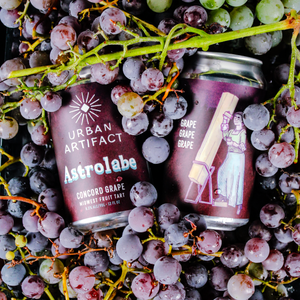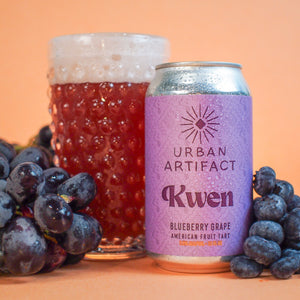Oktoberfest 2017 heralds the launch of a project nearly a year in the making: Tricorne, a Tart Pawpaw New England India Pale Ale (or TPNEIPA). Tricorne is a collaborative effort between ourselves at Urban Artifact and the fantastic team of the Cincinnati Samuel Adams production brewery. Working on this project has been, sincerely, a labor of love and has taught us a lot and helped to expand our personal brewing culture in unexpected ways.
From shiitakes to guavas to vanilla beans, we have a healthy obsession with ingredients. We spend a lot of time talking about and sharing processing techniques, boasting about beautiful produce purchased or foraged, arguing over the best way to peel mangos (what idiot takes the skin off FIRST), and so on. We had largely agreed, however, that we would avoid turning to flavorings, which has worked out well. Not having flavorings to rely on has forced us to get better at ingredient sourcing, for one. We’ve also gotten much better at figuring out the best ways to use and get the most flavor out of whole fruit. I mean, with this practice the Midwest Fruit Tart variants likely wouldn’t have been nearly as good or consistent.
Come Early spring 2017, we set our recipe and concept for Tricorne and started trying to figure our fruit dosing rates. It soon became apparent that there was very little in the way of frozen pawpaw in the market to be found and the samples that we did come across were of less-than-ideal quality. After some testing and blending, it was clear that no matter what we did, whole fruit just wasn’t going to give us the flavor we wanted or needed in this beer. In order to accomplish a project like this, particularly on this scale, using whole fruit to achieve the desired flavor profile simply was not practical. Tragically, however, the tropical yet custard-like flavor profile of overly-ripe pawpaws still seemed to be the ideal match for this beer. So, we did what any reasonable people do in a situation foreign to them: we brought in some experts.
It is not often that a newer, smaller brewery is afforded the opportunity to create their very own flavor from scratch. Thankfully for us, we had both the pull that Sam Adams has in Cincinnati and our friends over at Wild Flavors (due in large part to the persistence of Danny G.), we got to go through the flavor creation process over the course of a couple months. The process itself is not unlike creating any recipe from the ground up and relies largely on the knowledge of experts and the trust you have in your taste buds.
The process began simply enough with a meeting between all parties involved. Sam Adams, Urban Artifact, and of course Wild Flavors. We met over beers (duh) and discussed our goals. Naturally derived flavor designed to complement and enhance the flavor & aroma of our collaboration beer. At this point in time, we new little more than we wanted to make a New England IPA, we wanted to make it tart, and we wanted to use Ohio’s only native fruit, the pawpaw. Using our tart pale ale, Finn, as a guide, we discussed acidity levels, hop flavor goals (tropical all the way!), and the presence and type of pawpaw flavor desired.
Pawpaw comes in several different varieties that range in flavor from banana like, to mango-esque, to vanilla custard. The goal here was to find the perfect flavor that 1) tasted distinctly like pawpaw and 2) was a perfect blend for our desired end beer flavor profile. This is where the experts at Wild Flavors took over. They left that meeting with a growler of Finn in hand and went back to their lab to start creating.
After another month, Wild Flavors came back with two different flavor creations in hand. The first was far more focused on the custard derived flavors that pawpaw brings to the table. Mildly tropical, a hint of vanilla, and big fresh custard aromatics. The second highlighted the tropical aspect of fresh pawpaw fruit. Big banana, mango, and papaya, a literal match made in heaven for the tropical fruit hop flavors we were aiming for. The key next step was determining how do we utilize one or both of these flavors, and at what dosing rates.
This is where the experts in Boston stepped in for Sam Adams. Quick on the draw, they whipped up a pilot batch of a New England IPA and shipped it our way. At this point in time, we conducted a litany of bench trials consisting of samples with varying levels of acidity and varying levels of the two pawpaw flavors, as well as every combination in between. This process, while extremely fun, took quite a while and consisted of some spirited debate. There were those, like Bret Kollmann Baker of Urban Artifact, who preferred the custard forward pawpaw flavor and others, such as Adam Brandt of Sam Adams, who had a penchant for a more subtle custard note in the beer opting instead for more tropical inspired flavor. In the end, we all finally agreed upon what came down to basically a 70/30 blend of tropical forward to custard forward pawpaw notes.
With the final ratio in hand, the last thing left to do was what we all do best, execute. The wheels began to turn, Wild Flavors produced a full-scale batch of our custom created flavor, Urban Artifact began souring wort, and the originators at Sam Adams did what they do oh-so-well and brewed the full-scale batch of Tricorne, combining all our efforts into a drinkable pint.
As you can see, we really learned quite a bit from the flavor building experience. After going through the development process, the discussions about brewing culture and whether using flavoring should be part of our identity or not mostly faded away. Honestly, it became difficult to not see this flavoring, which Wild Flavors, Sam Adams and ourselves spent so much time and effort honing, as a whole ingredient. Consider wine: the final quality of the wine is largely seen as an indicator of how good the grapes were, not the vintner. The relationship between brewers and their beer is essentially the opposite of this last example, so it seems disreputable or perhaps shameful to not openly attribute some of that accomplishment to use of flavorings. Personally, if you’re open and transparent about the use of flavorings, it now seems like a viable option when natural ingredients fail. Not that we will trade splitting vanilla beans and zesting orange peels for jugs of extract anytime soon, but it’s not off the table.
Cheers,
Bret Kollmann Baker
Chief of Brewing Operations







